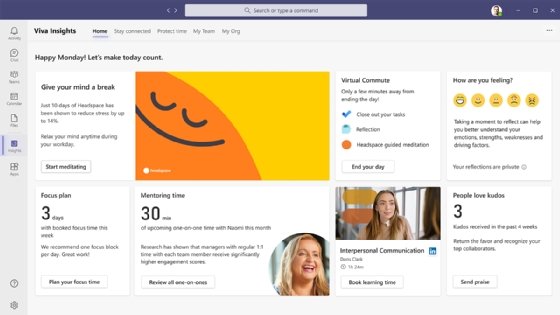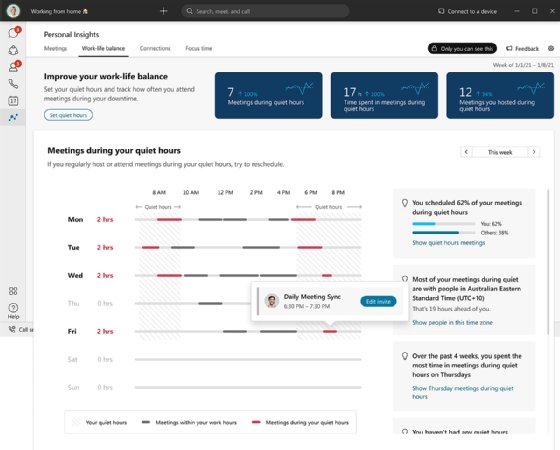
Keeping tabs on employees in the hybrid workplace
Companies want better ways to determine if their employees are mentally healthy or are at risk of a breakdown in the hybrid workplace. Vendors line up to meet the demand.
The shift to the hybrid workplace is on, and tech companies have aimed their products at helping businesses tackle the challenge of ensuring at-home employees avoid burnout.
Microsoft, Cisco, Citrix and others have tailored their offerings to the hybrid model, adding more insight into employees' emotional states. A Microsoft survey of corporations found that only 38% of employees thrived at home during the pandemic, versus 61% of executives.
"The data is clear; our people are struggling. And we need to find new ways to help them," Microsoft executive Jared Spataro said in the company's hybrid work report.
The mental toll from constantly working at home has not convinced employees to work full time in the office. A PwC survey released in January found that 55% of workers intended to stay home at least three days a week.
Allowing them to do that will require technology that monitors for excessive stress. This year, Microsoft announced an intranet-like platform, Viva, that includes wellness metrics. Viva's MyAnalytics feature makes recommendations based on how employees work, like setting time aside for breaks. It delivers anonymized data to managers and executives, noting when after-hours or excessive meetings could stress teams.
Cisco will add more data to Webex's People Insights feature this summer. The video conferencing platform will offer customized suggestions to employees, like altering their schedules if they are consistently late to meetings. Supervisors get anonymized data on broad trends.
Citrix has incorporated wellness-focused microapps into its Workspace SaaS platform. With the apps, enterprises can track their workforce's happiness through surveys and announce positive news, like employee recognition awards.

Avoiding Big Brother monitoring
Technology companies focus on well-being metrics because tracking an individual's productivity draws resentment, Gartner analyst Helen Poitevin said.
"The cost of collecting [productivity data], from a culture perspective and a trust perspective, is much higher than the value you can get from the data collected," she said.
Indeed, vendors are sensitive to charges that their products are intrusive. Microsoft faced a backlash when it introduced Productivity Score for the 365 suite last year. The company said it meant to measure how well an organization used Microsoft software. Still, critics called it a "full-fledged workplace surveillance tool," and Microsoft dropped individualized data from the software shortly after its general availability.
Cisco executive Jeetu Patel said the company did not design Webex's People Insights to scrutinize employees and report to their bosses.
"We are vehemently opposed to actually using these technologies for inspecting," he said. "[The feature is] not so that your manager can keep an eye on you."

Not all vendors shy away from that kind of monitoring. Companies like ActivTrak and Teramind sell software that explicitly reveals how many hours employees spent on business activities during the day. ActivTrak CEO Rita Selvaggi said data such as time expended in job-relevant applications and websites helps companies improve business operations.
"Having visibility into that work gives employers and managers a sense of comfort that productive work is being done," she said.
Myles Block, chief administrative officer at York International, uses ActivTrak to keep tabs on workers. York, an insurance broker based in Harrison, N.Y., did not have an employee revolt when it implemented the tool, he said. Some workers even wanted to extend tracking hours so they could get credit for late-night work.
"People want to do a good job," he said. "Responsible employees want to be held accountable at the end of the day."
Still, enterprises must exercise discretion when using the software, Block said. Using the tool in a "Big Brother" manner is inappropriate. Instead, companies should use the technology to identify issues when problems arise.
"If an employee is putting out a good work product, I think the worst thing you can do is start nitpicking them over an hour-and-15-minute lunch break," he said.
Even if a company implements this kind of monitoring, that doesn't mean its output will improve. Forrester Research analyst David Johnson said it is challenging to determine desk worker effectiveness. Pegging evaluations to metrics also encourages employees to game the measurements, he cautioned.
"If you want to track minutes [worked], then you'll get minutes," he said.
Block said the information companies receive from these applications is only a piece of the puzzle in supervising remote staff.
"Anyone who thinks an algorithm is going to replace the need for management is using the tool wrong," he said.
Mike Gleason is a reporter covering unified communications and collaboration tools. He previously covered communities in the MetroWest region of Massachusetts for the Milford Daily News, Walpole Times, Sharon Advocate and Medfield Press. He has also worked for newspapers in central Massachusetts and southwestern Vermont and served as a local editor for Patch. He can be found on Twitter at @MGleason_TT.








